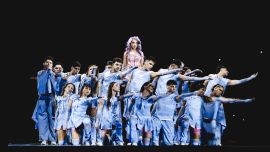From Marx and Engels’ “All that is solid melts into air” to Jim Jarmusch’s fifth golden rule “Nothing is Original,” German artist Julian Rosefeldt (b. 1965) delivers an impressively accomplished work, which takes the viewer on a fast-paced journey through the art of the 20th century by means of a very particular art form: the manifesto.
Rosefeldt did a painstaking amount of research before stopping at more than 50 published texts by some of the most prominent minds of the last century, from artists to theorists, filmmakers, architects, and dancers, covering the major art movements such as Futurism, Dadaism, Constructivism, Surrealism, Pop Art, Fluxus, Conceptual Art, and Minimalism, with a bonus vignette about cinema.
His Manifesto is a series of 13 short films, each dedicated to a bloc of art manifestos, set in everyday scenarios where characters from all walks of life go about their business while effortlessly declaiming pieces of those manifestos.
And then there’s Cate Blanchett, although there’s no “then” about her: it speaks volumes about a performer when their artistry becomes so intertwined with their work that they become their work and vice versa. Blanchett plays 13 characters in a stunning tour de force nd, needless to say, in her widest proof of performance range to date. She embodies a homeless man, a broker, a worker t a garbage incineration plant, a CEO, a tattooed punk, a scientist, a funeral speaker, a puppeteer, a conservative mother, a choreographer, a news anchor, a reporter, and a teacher, all of whom are endowed with different accents, appearances and demeanours.
There is a constant flow of point and counterpoint in the screening of these videos. As the funeral peaker, a plucky, black-netted Blanchett channels Tristan Tzara’s Dada Manifesto: “Abolition of logic: Dada. Abolition of memory: Dada. Abolition of archaeology: Dada. Abolition of the future: Dada. Dada is still shit. But from now on we want to shit in different colours.”
Another scene shows Blanchett as a dapper CEO at a party, talking in an assertive tone to some guests efore reading her speech from cue cards. And while she’s reciting Wyndham Lewis’ 1914 Manifesto about the “great art vortex,” a nearby screen interrupts its showing of Blanchett as a scientist declaiming Suprematist and Constructivist texts to display the image of a solid-coloured spiral staircase reminiscent of a vortex.
Rosefeldt’s Manifesto is screened at Proa in three rooms on the ground floor, with an upper room dedicated to information about artistic manifestos and the different art movements featured in the installation. If you go with a non-English speaker, be warned: the artist insisted on not marring the videos with subtitles. You will find sheets with the Spanish translation of every video next to each screen, courtesy of the Proa team which worked closely with Rosefeldt. But non- English speakers may need to set aside more time to experience the installation, as reading the texts before watching the videos may be necessary to enjoy them more fully.
Manifesto is not Rosefeldt’s first foray into filmmaking, he is quite an accomplished video artist and it shows. The cinematography by Christoph Krauss is also to be commended. If at any point you struggle with the breadth and depth of the texts so aptly voiced by Cate Blanchett, the audio-visual material is quite an entertaining and immersive experience in itself. In fact, each short film pauses at the same time, when Blanchett looks directly into the camera and starts chanting in a monotone, artificial voice parts of a manifesto, before the moment passes and the videos fall back to their own pace. It is a stunning moment, not only aurally but also visually: as the chants from all the screens converge, you can turn and see a close-up of Blanchett’s face in different disguises on all those displays, and it’s remarkable.
If there is little doubt that watching Blanchett for hours on end is a thing of beauty, some may wonder about the purpose of Rosefeldt’s project. In an interview, the artist said: “It’s just like giving all these male voices to a woman, making them accessible and fresh. Freeing them from the weight of art history. These artists wanted to change the world, but the whole world is made up of teachers, conservative mothers and garbage workers. So this is a love declaration to life in general, and giving up this idea that the artist is separate from society.”
The last scene shows Blanchett as a teacher spouting Jarmusch’s Golden Rules and Dogme 95 filmmaking canons to elementary school students, all based on the notion that “Nothing is Original. Steal from anywhere that resonates with inspiration or fuels your imagination” and ending with Lebbeus Woods’ words: “Tomorrow we begin together the construction of a city.”
Whether or not this is the idea you will take with you when leaving the installation at Proa, there is enough to make you wonder and ponder for quite some time, from Blanchett’s matchless performances to the contrast of having everyday people declaim such potent words.
When and where
Manifesto, by Julian Rosefeldt, is on show at Proa, until November 5. Av. Pedro de Mendoza 1929, La Boca / Caminito, www.proa. org. Tuesday to Sunday, 11am to 7pm. General admission: 50 pesos. Discounts available.
























Comments